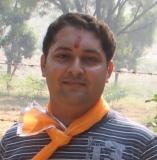|
Author
|
 Topic Topic 
|
|
shreekant22
PRO - Pushtikul.com / P.E.M. January 2004
    

1853 Posts

|
|
 Posted - 24 March 2005 : 14:50:25 Posted - 24 March 2005 : 14:50:25
Jai Shree Krishna Badhai BadhaiBadhai Badhai
Jhulat Dol Radhika sang
Govardhan parbat ke oopar, Khelat ati ras sang
Pratham Khel Radhe mann hulasyo, Kesar liptat aang
Dujo khel rachyp Chandravali, Abir.. Gulal.. Surang
Teejo Khel keeyo Lalitadik, Agin kumari sang
Chotho khel keeyo vrundavan, Mohyo Rasik Anang
 Badhai ho.... ho ho ho ho holi hey.....
Edited by - shreekant22 on March 24 2005 15:13:13 Shree Vallabha dheesh ki jai
|
Jigna
Pushtikul Elite Member - October 2003
 

219 Posts

|
|
 Posted - 24 March 2005 : 15:20:03
Posted - 24 March 2005 : 15:20:03
Dear Vaishav Friends,
Jai Shree Krishna,
I wish all my friends a Very Happy Holi. May this festival of colours bring in more colour and joy into your lives.
Love
Jigna

|
Vasant Punjabi
Vice-President & Pushtikul Elite Member - May 2003
    

1047 Posts

|
|
 Posted - 25 March 2005 : 05:28:12
Posted - 25 March 2005 : 05:28:12
Jai Shri Krishna,
BHADAI TO ALL ON DOL UTSAV.
----------------------------
JHULAT DOL NANDKUMAR
CHAN-HU-AUR JHULAVAT VRAJ SUNDHARI GAVAT SARAS DHAMAR
VAM BHAG VHUSBHAN NANDINI SAJE SAKAL SINGHAR
AASKARAN PRABHU MOHAN JHULAT VRAJ KE PRAN AADHAR.
Vasant

|
gopal
Pushtikul Elite Member - August 2003
    

1221 Posts
|
|
 Posted - 25 March 2005 : 10:00:18
Posted - 25 March 2005 : 10:00:18
Jai Jai ShriGokulesh
Braj mein hori khelat Nandlal.
Kesar rang ki keech bhai hai,
Chahun or udat gulal,
Nachat gopal.
Braj mein hori khelat Nandlal.
Baajat jhanjhar, dhol, majari aur khartal,
Braj ki nari sangh hori khelat,
Nachat dede taal, sakhi.
Braj mein hori khelat Nandlal.
(This song sung by swaminiji's describes Nandlal, as young Krishna is called, playing hori with the women of Brajbhoomi - the area comprising Mathura, Vrindavan, Gokul and Barsana that are associated with Krishna and Radha. 'Red colour is flying in all directions and the mud has turned slushy with saffron coloured water. Friend, dance to the beat as Nandlal is playing hori' - so the song goes.)
Holi - the word was originally hori or happiness in Brajbhasha, a dialect of Hindi language. In fact, in Braj, people still call Holi, Hori. The verse above happens to be the hori, as the song of Holi is called.
There are many myths surrounding this question and many of them link the festival to Krishna, right from the day this son of Devaki and Vasudev was brought to Gokul as an infant and placed in the care of foster parents. Born in a prison in Mathura during the night, he was taken away by his father to escape the wrath of his uncle, King Kans.
Time passed. The people of Gokul had just harvested a good wheat and gram crop - the first of the season. Winter was on its way out, the spring flowers were budding and it was a full moon day. Also, it was the month of chait or the first month of the Hindu year. Since everything around them gave the message of new life and the Nand household had an heir after a long time, the people of Gokul decided to celebrate. So wheat and gram were roasted, flowers of different colours were powdered and the women prepared sweetmeats. There was great singing and dancing to the beats of the dholak (the two-sided drum).
This became an annual ritual following the harvest and Hori became a festival. There is an underlying element of eroticism in Holi. In the exultation and revelry, in the physical act of smearing colour, in the mock battles of throwing coloured water and gulal at each other. Spring itself is the season of love. And this festival seems to acknowledge and greet that.
But the origins of the eroticism lie in the story of Lord Krishna's (the great lover in Hindu mythology) fabled love for his beloved Radha. Holi is spread over two weeks in Mathura and Vrindavan, the two ancient cities Krishna has been associated with. Here, along with the coloured powder and water, lively processions come out in the streets, folk songs and dances are performed to the rhythmic beat of dholkis (folk drums), the mirror embroidered vibrantly coloured long skirts of the women swirling and swinging in gay abandonment.
Hindu mythology is full of stories about Lord Krishna's childhood pranks. And that of his youth when he with his mischief and the sweet sounds of his bansuri (bamboo flute) captivated the hearts of the gopikas (the cowherd girls), amongst whom he grew up. Among the gopikas, especially, was his beloved beauteous Radha. Most of the folk songs and folk dances, called Raas-Lila, in Northern India performed during Holi are recitals of Radha's and Krishna's love. The separations, the pining and the longing, the clandestine meetings, the adoration . . .
A game called "Huranga" is played during Holi even today symbolizing the Radha-Krishna love play. The men of Nandagaon, where the youthful Krishna played his pranks, and the women of Barsana, Radha's birth place, come together and clash. The objective being that the men put a flag on Radhika's temple at Barsana, symbolizing their victory over the women of Barsana, while the women beat the men with stout sticks to keep them away.
A land of ancient origins, intricate cultures interwoven over great periods of time, Holi portrays the diversity and the mythology of India to our senses even today.
Jai Jai ShriGokulesh Parivaar, Baroda

|
manoj_thakker
Entry Level Member

52 Posts

|
|
 Posted - 25 March 2005 : 12:48:29
Posted - 25 March 2005 : 12:48:29
Dolottsav at Kakaroli
The picturesque haveli of Shri Dwarakadhishji, on the banks of the Rajasmand resevoir, resonates with the sound of festival drums. Like Shri Nathji, the Lord here has cattle drums playing in the Nagakhana of the Haveli during the times when the main darshans are open. The Lord swings in his festive Dol from the afternoon till the evening. The excellent Bundi style paintings on the upper walls of the main courtyard are, sensibly enough, covered up. A screened section is created opposite the swing for those who wish to view the festivites without being covered by colour.
In my personal experience, the dolottsav at Kakaroli is far more lively and "spirited" than the one at Nathadwara. The mukhiyaji and the Goswamies at Kakaroli seem to have put greater heart into the seva here and much fun is to had by all. The singers at Kakaroli sing spiritedly while the mukhiyaji loads up his pichakari (festive syring) with colour and, aims the colour at spectators around the courtyard. No one really escapes, even those wanting to only catch a glimpse of the festivities and actually avoid the colour, get caught out. During our visit, we found that like us, many had cleaned up after the Dol at Nathadwara and came here to witness the Utthapan or Bhog arti. Dressed in clean clothes, most of us had no desire to get them wet and dirty again, but, the Chanchal Lord of Dwaraka caught us all out !
The range of colours used here is far more modern as well, for example, they were using purples, blues, yellows and greens besides the traditional white and pink. In this sense, Nathadwara is still very conservative, and no one is even allowed to bring such colours into the haveli. The heavy use of kesudo adds to the "fun" element at Kakaroli.
Lord Shri Dwarakadhishji swings almost within reach of his devotes. In addition to all his festival jewels, He also wears a vagh-nakh (2 claws of a tiger, mounted on a gold pendent) to ward off the evil eye. The dark image of the Lord is made darker still by heavy use of "lagauo" - a dark sticky substance used to attach jewels, tilak and eyes of the Lord to the idol. His charvagh is stuck back with lagauo as are the flowing ends of the colourful scarf. The Lord's dreamy, beautiful eyes capture the hearts of the devotees as the foliage covered hindolo swings slowly back and forth. The languid pace of the swing contrasts wonderfully with the pace of the music and the vigour with which kesudo is sprayed on to the vaishnavs. It was a wonderful darshan indeed !
During our visit in 1998, after the arti, temple servants who took part in the main sevas for the day were given special rewards for all their hard work by a balak of the Kakaroli house.
By author Bhagwat Shah. of: pushti_marg@geocities.com
 Edited by - manoj_thakker on March 25 2005 13:00:38
Edited by - manoj_thakker on March 25 2005 13:00:38
Shree Goverdhannath Ki Jai

|
nira
Entry Level Member

43 Posts

|
|
 Posted - 25 March 2005 : 18:22:36
Posted - 25 March 2005 : 18:22:36
JAI SHREE KRISHNA TO ALL DEAR VAISHNAVS,
JHULAT DOL DOU ANURAG !
KESAR AUR GULAALA SON BINJE LAPTE BAAGE !!1!!
LALITADIK MIL JULAVAT GAAVAT EK EKTE AAGE !
BAJAT TAAL PAKHAVAJ AAVAJ MURLI SANG SUHAGE !!2!!
DET ASIS CHALI BRAJSUNDARI FIR KHELENGE FAGE !
KRUSHNADAS PRABHU KI CHABI NIRKHAT ROOM ROOM RAS PAAGE !!3!!
HERES WISHING ALL THE VAISHNAS A VERY HAPPY HOLI AND LETS ALL PLAY HOLI IN MANSIK WITH OUR PRIYA SAKHA SHREE KRISHNA...
SEE YOU ALL IN MANSIK TODAY...
JAI SHREE KRISHNA
NIRA
nvshah

|
admin
President - Pushtikul.com
  

422 Posts

|
|
 Posted - 26 March 2005 : 01:42:03
Posted - 26 March 2005 : 01:42:03
Dear All,
Wishing you all a very happy holi !!
I am glad that we have so many bhavik Vaishnavs who have composed such nice kirtans for Holi Dolotsav.
I congratulate all of you for such wonderful compositions & wish you once again a very happy holi !!
Shri Vallabhadhish ki Jai !!
Anand A. Majethia
President

|
anjan82
Entry Level Member

46 Posts

|
|
 Posted - 12 March 2009 : 11:25:51
Posted - 12 March 2009 : 11:25:51
Dolorav ni khub khub Badhai
Jay Shree Krishna

|
shreekant22
PRO - Pushtikul.com / P.E.M. January 2004
    

1853 Posts

|
|
 Posted - 12 March 2009 : 19:29:00
Posted - 12 March 2009 : 19:29:00
Jai Shree Krishna
Badhai to all Vaishnavs on Dolotsav.
Shree Vallabha dheesh ki jai

|
|
